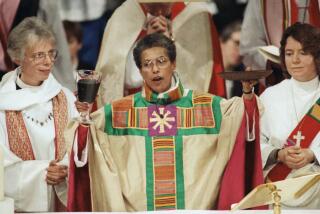Heeding God’s Call Later in Life : * Religion: More older people are entering seminaries, citing the value of a worldlywise clergy. However, critics fear some are unsuccessful people who are career hopping.
WASHINGTON — God finally caught up with Monte Canfield Jr. at age 50, just as Canfield had begun to savor the fruits of three successful careers.
“I kept running away from God,” Canfield says, still surprised by the effect that his call to the ministry had on his life.
“It came in a thought, a voice, whatever you want to call it. It was very clear. It said, ‘It’s not too late.’
“My reaction was not to rush off and put ashes on my forehead, but to dismiss it. I thought, ‘I’m too old, I’ve had too many careers,’ ” says Canfield, who rose to high positions under three Administrations, was a vice president in a prestigious corporation and ran his own energy conservation business.
But last year, rather than retiring, Canfield entered the United Church of Christ’s Eden Theological Seminary in St. Louis.
He is one of a growing number of seminary students who are launching second, third, fourth and even fifth careers in their churches or synagogues. These older seminarians, many having first-hand experience with “real-world” crises--divorce, substance abuse, teen-age pregnancy, war--are bringing a new approach to religion.
This approach--which they describe as steeped in personal spiritualism yet grounded in the precept of accompanying, rather than guiding, people through life--has ignited a new debate over older seminarians.
Some seminary teachers say the maturity and worldly experience of these students enable them to better understand and help their congregations. Others fear many of them are turning to seminaries after failing in other careers and are bringing their personal problems to the ministry.
Seminaries “have become a place people go to get their lives back together,” says Jackson W. Carroll, a sociologist and professor at the nondenominational Hartford Seminary in Connecticut. “It has become a place to get whole again, as well as to discover a call.”
But Canfield, like many of his older colleagues, denies such selfish motives.
“I don’t feel the pressure of having to achieve anything. Thirty-five years ago, I would have been thinking about how I would become a bishop. I don’t want the limelight now,” he says, “and that’s very satisfying.”
In general, the demographic profile of seminarians in the United States has changed more in the last 20 years than it has in the last two centuries, according to Joseph O’Neil, a Jesuit priest who has gathered background on about 800,000 men and women who have attended accredited U.S. seminaries over the last 40 years. A total of 173 seminaries are accredited by the Assn. of Theological Schools.
O’Neil found that today’s seminarians are older--by 10 years, on average--than those of a generation ago. These days, three-fourths of the nation’s roughly 56,000 seminarians have had at least one or two previous careers.
O’Neil’s data also show that about one in three American seminarians are women, compared to one in eight 10 years ago and almost none 20 years ago.
Between 1972 and 1987, the number of women preparing for ordination soared from 1,077 to 6,108, more than a fivefold increase. But women still are entering the ranks of the clergy at a much slower rate than they have entered such other fields as law and medicine. In fact, the percentage of women enrolled in master of divinity programs during the 1986-87 academic year was comparable to the number of women entering medicine and law a decade earlier.
The background of new seminarians has changed in other ways as well, the study found. For example:
* More than half of today’s seminarians have children. In the 1960s, very few were parents; by 1975, about one in four had kids.
* Although male seminarians, on average, score below the mean on General Record Exams, women have consistently scored above average. O’Neil also found that women generally come from more affluent families and have higher current incomes than men.
* The proportion of seminarians without college degrees has doubled from 5% in 1975 to 10% in 1989, and those with no college experience rose from 1% to 4%.
O’Neil’s findings feed a growing debate among older-generation clergy over the challenges the new seminarians bring to American religious tradition.
“We’re not drawing the brightest and the best (as seminaries did) in the 1950s and ‘60s,” says Carroll, the Hartford professor. The declining academic ability of the seminarians has several causes, he says, including the diminished presence of mainstream churches, the waning of formalized religion in the United States, the low salaries received by clergy and their lessening status.
But even as mainline Protestant, Roman Catholic and Jewish denominations lose membership in the United States, the number of people presenting themselves for ordination continues to grow. The newly merged Presbyterian Church (USA), for example, has seen membership drop from more than 4 million to less than 3 million in about a generation, but the number of its clergy rose 28%, to 15,726, between 1976 and 1986.
In contrast, the Roman Catholic church is the only major denomination with an acute shortage of clergy. In just 25 years, the number of men preparing for the priesthood dropped 80%, from 42,000 in 1966 to 8,394 in 1989-90.
Taking issue with Carroll, David L. Crawford, Princeton Theological Seminary admissions director, says he sees no slump in the academic ability of applicants. Many students were highly successful in the secular world and have entered the seminary to seek a greater fulfillment, Crawford says. As an example, he cites the president of last year’s graduating class, who had been a respected heart surgeon.
But the texture of Princeton’s entering class has changed, Crawford concedes. Two decades ago, almost all its students were single men in their early 20s. Last year, only about 20% of the students were in their 20s, and 50% were married.
Crawford says he would like to see more young applicants entering Princeton on the basis of simple economics: They could be in service longer.
Still, argues Clifton W. Kerr, director of admissions at Eden Theological Seminary, the cost of training older people who will be pastors for shorter periods may be higher per year of service, but it is a small concession for a better ministry.
“We may no longer be attracting the elite young male,” says Kerr. “They’re not choosing the pastoral ministry and instead are going into law and medical school. But this may be a good sign for us. (Now students) may be coming for the right reasons--the reasons we want them to come.”
Maturity, integrity and commitment are at least equal in importance to academic ability, many seminary admissions officers say, reflecting the demands of congregations and ministers in the field.
“I’m not interested in having a straight-A student minister at my side,” explains Tyrone Williams, a Baptist minister in a drug- and violence-ridden area of northeast Washington. “I need someone with compassion who can talk to a child who just lost her mother to a stray bullet. It’s time the ministry stopped preaching world politics and rolled up its sleeves and got its hands dirty.”
Many schools are adapting to today’s seminarians and the changing role of the clergy. In a move to develop rabbis who are not only great scholars but also receptive listeners and accessible community leaders, the faculty of the Conservative movement’s rabbinical school at the Jewish Theological Seminary in New York voted to adopt a curriculum that emphasizes professional skills and personal religious growth as well as standard academic and religious trainning.
“Our students come out of the America of the 1980s and ‘90s. They reflect the new needs of congregations,” says Rabbi Neil Gillman of the Jewish Theological Seminary. “They are not as politically involved as the students of the ‘60s. They are more interested in counseling. They are more concerned with spirituality and religion and issues of meaning than the more cerebral. They want to work with people rather than books.”
Marcia Graham, a grandmother from Huntsville, Ala., and a second-year student at Eden, is an example of the student Gillman describes. After ordination, Graham hopes to be a chaplain of a jail or hospital as well as to have a congregation.
“I always felt some call to share walking with people in life--not to do something for them, but to share,” says Graham, 45, who worked as an executive director of a United Way agency and raised her children before going to seminary.
And Graham believes her experiences in the real world have best prepared her for pastoring. “I think to be a pastor is to listen to people’s hearts in a very deep and sensitive way,” she says. “My ability to listen and give support is strengthened by having lived life--both its successes and failures.”
Carol Davidson, a 36-year-old rabbinical student at Jewish Theological Seminary, began her first career at 5 as a child prodigy pianist.
Like many others who are coming late to the ministry, she believes she has a richer understanding of the world and can better “address the needs of today’s broken society” than her younger colleagues.
“There’s a whole world out there which I have been a part of,” says Davidson. “What I want to do is to bring a little bit of the holy in to help (people) through life.”
More to Read
Sign up for Essential California
The most important California stories and recommendations in your inbox every morning.
You may occasionally receive promotional content from the Los Angeles Times.










